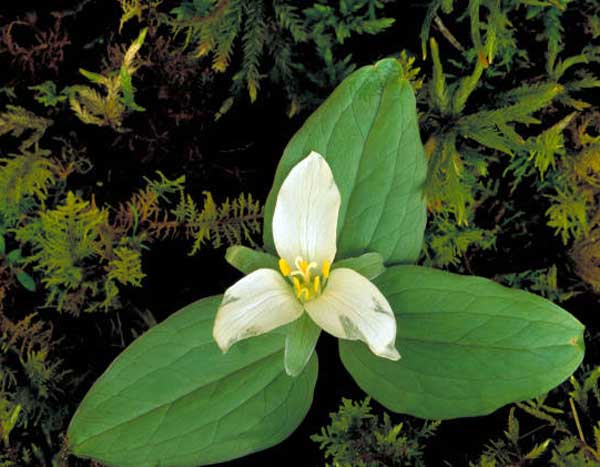
Trillium nivale. Photo: U.S. Fish and Wildlife Service
Classification System: APG IV
Superregnum: Eukaryota
Regnum: Plantae
Cladus: Angiosperms
Cladus: Monocots
Ordo: Liliales
Familia: Melanthiaceae
Tribus: Parideae
Genus: Trillium
Species: Trillium nivale
Name
Trillium nivale Riddell
Vernacular names
English: snow trillium, dwarf white trillium
Trillium nivale, the snow trillium[2] or dwarf white trillium, is a species of flowering plant in the family Melanthiaceae. It is native to parts of the east and midwest United States, primarily the Great Lakes States, the Ohio Valley, and the Upper Mississippi Valley, as far north as central Minnesota.[3][4][5]
Trillium nivale is a perennial herbaceous plant that flowers late winter or early spring, occasionally while snow is still on the ground.[6] Along the Ohio River valley, flowers may be seen in early March. At its northern limit in Minnesota, it blooms in early April.[7] Along with the eastern skunk cabbage (Symplocarpus foetidus), T. nivale is one of the earliest flowering spring ephemerals.[8] Given its winter hardiness, one would expect the range of T. nivale to extend farther north, but curiously this is not the case.[9]
Soon after pollination the pedicel turns downward, so that by the time the fruit is mature, it is hanging below the leaves. In June, the seeds are shed and the entire portion of the plant above ground suddenly disappears. The seeds are dispersed by ants, which may account for the low genetic diversity reported in some plant populations.[5][9]
Trillium nivale is smaller than many of the other species in the genus, seldom reaching a height of more than 9 cm (3.5 in). Unlike most trilliums, it does not grow in leaf mold, preferring limy sandy gravel, crevices in limestone, or calcareous mineral soil.[7]
Like other Trillium species, T. nivale has a one-leaf vegetative stage followed by a three-leaf vegetative (juvenile) stage. After twelve or more years of vegetative growth, the plant finally reaches its three-leaf reproductive (flowering) stage. In some populations, there may be ten or more one-leaf plants to each flowering plant. The latter has an indefinite life span of many years, often living for decades.[5][9]
Bibliography
Case, Frederick W.; Case, Roberta B. (1997). Trilliums. Portland, Oregon: Timber Press. ISBN 978-0-88192-374-2.
References
"Trillium nivale". NatureServe Explorer. NatureServe. Retrieved 2008-05-02.
"Trillium nivale". Natural Resources Conservation Service PLANTS Database. USDA. Retrieved 15 December 2015.
"Trillium nivale". World Checklist of Selected Plant Families (WCSP). Royal Botanic Gardens, Kew.
"Trillium nivale". County-level distribution map from the North American Plant Atlas (NAPA). Biota of North America Program (BONAP). 2014.
"Trillium nivale Riddell (Snow Trillium)". Minnesota Department of Natural Resources. Retrieved 18 November 2019.
Stritch, Larry. "Snow Trillium (Trillium nivale)". United States Forest Service. Retrieved 7 October 2019.
Case Jr., Frederick W. (2002). "Trillium nivale". In Flora of North America Editorial Committee (ed.). Flora of North America North of Mexico (FNA). 26. New York and Oxford – via eFloras.org, Missouri Botanical Garden, St. Louis, MO & Harvard University Herbaria, Cambridge, MA.
Case & Case (1997), p. 110.
Martin, John N. (1935). "The Distribution and Life History of the Trillium nivale Riddell". Proceedings of the Iowa Academy of Science. 42 (1): 49–54. Retrieved 25 October 2019.
Retrieved from "http://en.wikipedia.org/"
All text is available under the terms of the GNU Free Documentation License

